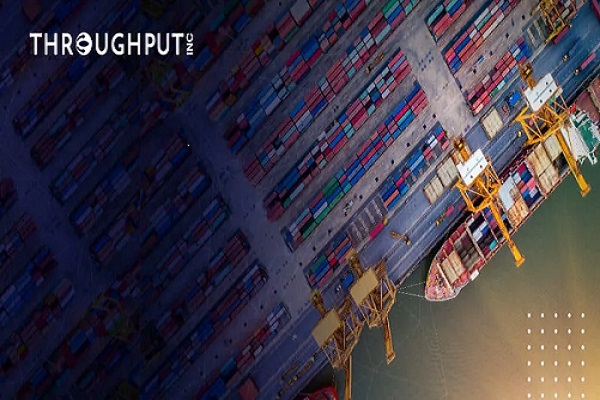Artificial Intelligence in Transportation and Logistics: 2025 Trends & Impact

The use of Artificial Intelligence in Transportation and Logistics is redefining how goods and services are moved across the globe. In 2025, businesses are actively integrating AI-powered systems to streamline operations, boost productivity, and make data-driven decisions that reduce costs and improve delivery speed. With the logistics industry facing increased demand, rising fuel costs, and tighter delivery windows, AI is emerging as a game-changer.
This blog explores how artificial intelligence is revolutionizing the transportation and logistics industry, highlighting current applications, benefits, and what lies ahead.
The Role of Artificial Intelligence in Logistics Operations
Artificial intelligence by Throughput Inc helps logistics companies overcome daily operational challenges. From route planning to load optimization and warehouse management, AI is optimizing every link in the supply chain.
Key Benefits of AI in Logistics:
- Real-Time Route Optimization: AI algorithms adjust delivery routes dynamically based on traffic, weather, and delivery priorities.
- Inventory Forecasting: AI predicts stock requirements, helping companies reduce excess inventory and meet customer demand more accurately.
- Warehouse Automation: Smart robots and AI-powered systems improve picking, packing, and inventory accuracy.
These AI applications not only reduce errors but also save time, leading to faster and more reliable service.
AI in Fleet Management and Predictive Maintenance
Fleet operations are at the heart of transportation logistics. Maintaining vehicles, ensuring timely deliveries, and reducing operational costs are crucial. AI helps achieve these goals through intelligent fleet management systems.
AI Contributions to Fleet Efficiency:
- Predictive Maintenance: AI analyzes vehicle sensor data to predict breakdowns before they happen, minimizing unplanned downtime.
- Fuel Optimization: AI suggests more fuel-efficient driving patterns and routes, lowering fuel consumption.
- Driver Behavior Monitoring: AI tools monitor driver performance in real-time, promoting safer and more efficient driving practices.
By extending the life of vehicles and enhancing fleet reliability, AI improves profitability and service quality.
Artificial Intelligence in Urban Transportation Planning
As cities grow, managing traffic and public transportation becomes increasingly complex. Artificial intelligence plays a vital role in urban mobility by helping authorities and transport companies make smarter decisions.
AI Applications in Urban Transportation:
- Traffic Flow Analysis: AI-powered cameras and sensors monitor traffic and adjust signal timings to ease congestion.
- Smart Public Transit: AI helps plan bus and train schedules based on passenger data and demand forecasts.
- Shared Mobility Integration: AI coordinates ride-sharing, bike-sharing, and other mobility services to reduce urban congestion.
These innovations lead to faster travel times, better commuter experiences, and reduced environmental impact.
Automation and Robotics in Logistics
Another major area where artificial intelligence in transportation and logistics is making waves is automation. Robotics powered by AI are replacing manual tasks, especially in high-volume operations.
Current Use Cases of Automation:
- Autonomous Delivery Vehicles: Drones and self-driving vans are already being used for last-mile delivery in some urban areas.
- Smart Warehouses: AI coordinates autonomous robots to sort, move, and ship items with incredible precision.
- Packaging Automation: AI systems package items based on product size, reducing material waste and speeding up the process.
These AI-driven automation tools help businesses meet growing demand while maintaining consistency and speed.
AI and Supply Chain Visibility
Modern supply chains are global, complex, and vulnerable to disruptions. AI provides end-to-end visibility and transparency, making it easier to manage risks and meet delivery timelines.
How AI Improves Visibility:
- Real-Time Tracking: AI collects GPS and IoT data to show where shipments are at all times.
- Disruption Detection: AI flags delays due to weather, port closures, or geopolitical risks, enabling companies to take preventive actions.
- Smart Decision-Making: AI models simulate different logistics scenarios to help leaders choose the best response strategy.
With improved visibility, companies can maintain customer satisfaction even during unexpected challenges.
Environmental Benefits of AI in Transportation
Environmental concerns are pushing logistics companies to adopt sustainable practices. AI supports these efforts by optimizing resource use and reducing emissions.
Eco-Friendly Advantages:
- Lower Emissions: AI identifies routes and driving behaviors that minimize fuel usage.
- Electric Vehicle Integration: AI helps manage battery life, charging schedules, and range for electric fleets.
- Sustainability Planning: AI enables carbon tracking, helping companies set and meet environmental goals.
In this way, AI is not only increasing profits but also helping create greener supply chains.
Challenges of AI Adoption in Logistics
Despite its benefits, implementing artificial intelligence in transportation and logistics comes with challenges:
- High Initial Costs: AI systems and automation infrastructure require upfront investment.
- Data Privacy: Handling large volumes of sensitive operational and customer data must comply with regulations.
- Workforce Upskilling: Staff must be trained to work alongside AI and understand its outputs.
Still, the long-term ROI of AI adoption far outweighs these initial hurdles, especially as technology becomes more accessible.
Conclusion: AI is Shaping the Future of Logistics and Transportation
The adoption of artificial intelligence in transportation and logistics is rapidly accelerating in 2025. AI enables faster deliveries, optimized routes, safer operations, and eco-friendly logistics—all while reducing costs and enhancing customer satisfaction.




